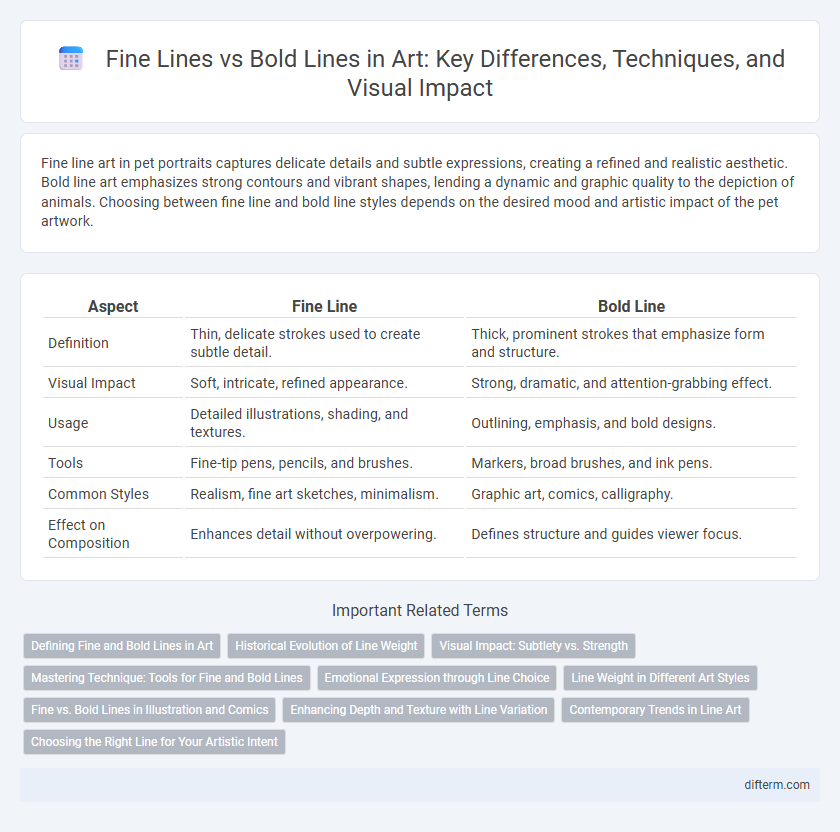Fine line art in pet portraits captures delicate details and subtle expressions, creating a refined and realistic aesthetic. Bold line art emphasizes strong contours and vibrant shapes, lending a dynamic and graphic quality to the depiction of animals. Choosing between fine line and bold line styles depends on the desired mood and artistic impact of the pet artwork.
Table of Comparison
| Aspect | Fine Line | Bold Line |
|---|---|---|
| Definition | Thin, delicate strokes used to create subtle detail. | Thick, prominent strokes that emphasize form and structure. |
| Visual Impact | Soft, intricate, refined appearance. | Strong, dramatic, and attention-grabbing effect. |
| Usage | Detailed illustrations, shading, and textures. | Outlining, emphasis, and bold designs. |
| Tools | Fine-tip pens, pencils, and brushes. | Markers, broad brushes, and ink pens. |
| Common Styles | Realism, fine art sketches, minimalism. | Graphic art, comics, calligraphy. |
| Effect on Composition | Enhances detail without overpowering. | Defines structure and guides viewer focus. |
Defining Fine and Bold Lines in Art
Fine lines in art are characterized by their thin, delicate strokes that emphasize detail, subtle contours, and intricate patterns, often used to create texture or highlight precision. Bold lines feature thicker, more pronounced strokes that convey strength, emphasis, and structure, enhancing focal points and defining major shapes within a composition. The strategic use of fine and bold lines shapes visual hierarchy, depth, and emotional impact in artistic works.
Historical Evolution of Line Weight
The historical evolution of line weight in art traces back to ancient cave paintings where fine lines conveyed delicate details, whereas bold lines emphasized form and structure in early sculptures. During the Renaissance, artists like Leonardo da Vinci utilized varying line weights to create depth and realism, marking a shift towards sophisticated chiaroscuro techniques. In modern art, the contrast between fine and bold lines evolved to express emotion and abstract concepts, reflecting changing artistic philosophies over centuries.
Visual Impact: Subtlety vs. Strength
Fine lines create a delicate and subtle visual impact, emphasizing detail and intricacy in artwork. Bold lines convey strength and confidence, making shapes and forms more pronounced and assertive. Choosing between fine and bold lines influences the overall emotional tone by balancing sensitivity with power in visual expression.
Mastering Technique: Tools for Fine and Bold Lines
Mastering the technique of fine and bold lines in art requires selecting the right tools such as fine-tipped pens, brushes with pointed bristles, and technical drawing pencils for intricate, delicate lines. Bold lines demand mediums like broad-nib markers, flat brushes, and charcoal sticks, offering strong, expressive strokes that define shape and contrast. Understanding the pressure applied and the tool angle enhances control, allowing artists to create dynamic compositions with both subtle details and striking emphasis.
Emotional Expression through Line Choice
Fine lines in art often convey subtlety, delicacy, and introspection, allowing nuanced emotional expression through gentle contours and intricate details. Bold lines create strong visual impact, evoking intensity, confidence, and heightened emotional states by emphasizing form and movement with striking clarity. The choice between fine and bold lines fundamentally shapes the viewer's emotional response and deepens the narrative conveyed by the artwork.
Line Weight in Different Art Styles
Line weight plays a crucial role in defining form and depth across various art styles, with fine lines often used in detailed, delicate works such as pen and ink illustrations or architectural drawings. Bold lines create strong visual impact and are commonly employed in graphic novels, comic art, and expressionist paintings to emphasize contours and convey drama. Artists strategically vary line weight to guide the viewer's eye and enhance the narrative within compositions.
Fine vs. Bold Lines in Illustration and Comics
Fine lines in illustration and comics create delicate, detailed visuals that emphasize precision and subtlety, enhancing texture and intricate character expressions. Bold lines provide strong contrast and dynamic emphasis, defining shapes clearly and driving viewer attention with impactful, graphic storytelling. Using fine vs. bold lines strategically balances softness and intensity, influencing mood and narrative clarity in sequential art.
Enhancing Depth and Texture with Line Variation
Fine lines create delicate texture and subtle shading, offering intricate details that enhance depth in artwork. Bold lines provide strong contrast and define shapes more clearly, establishing visual hierarchy and grounding the composition. Combining fine and bold lines strategically generates dynamic contrast, enriching the overall texture and dimensionality of the piece.
Contemporary Trends in Line Art
Contemporary trends in line art emphasize the dynamic interplay between fine line and bold line techniques, creating depth and contrast that enhance visual impact. Fine lines offer intricate detail and subtle texture, often used to convey delicacy and precision, while bold lines provide strong structure and graphic emphasis, anchoring compositions with visual weight. Artists increasingly blend these approaches to explore new aesthetic possibilities, balancing minimalism and expressiveness in modern artworks.
Choosing the Right Line for Your Artistic Intent
Choosing the right line in art significantly influences the mood and emphasis of a piece, with fine lines offering subtlety and intricate detail while bold lines convey strength and clear boundaries. Fine lines excel in delicate textures and nuanced shading, making them ideal for realistic portraits and detailed illustrations. Bold lines dominate in graphic art and comics, providing visual impact and guiding viewer focus effectively.
Fine Line vs Bold Line Infographic

 difterm.com
difterm.com